|
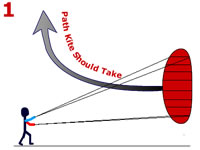 |
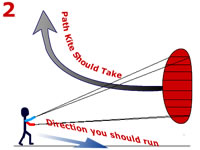 |
|
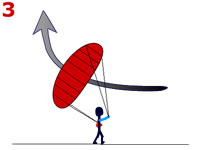 |
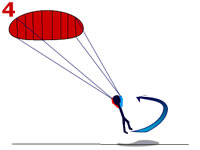 |
||
Kite jumping is probably the most dangerous form of power kiting. The pilot uses a large kite to lift him/her self off the ground for brief periods of time. Without doubt the most dangerous thing about kite jumping is the landing, which is difficult to control.
A stack of flexifoils or a four-line foil kite (a stable kite is advisable such as a Flexifoil Blade) Safety equipment is also recommended.
|
 |
 |
|
 |
 |
||
 |
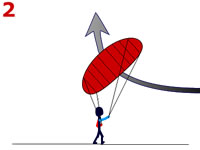 |
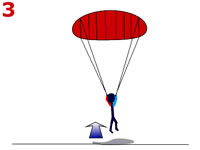 |
NB: The magnitude of your jump can be controlled by the distance down the edge of the window from where your kite starts. Starting low down the edge of the wind would equal “big air”, and from high up “small air”.
This jump does not quite achieve the level of air as the Sweep technique described above, however it is much easier to pull off stylish jumps because the pull is purely forwards. There is therefore no tendency for twisting in the air. {Ed - the level of jump betweeen the down-up jump and the sweep jump is up for discussion, as some reviewers have stated that the down-up jump actually gives them more air than the sweep jump. This is because they cannot brace themselves against the force of the kite sweeping through the power zone and therefore the jump seems to them to be weaker. It may be that this technique is better when used in conjunction with the pit (see below). If you have any views on this or anything on this site, then please post queries etc in our forum or drop us an email}
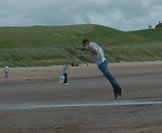 |
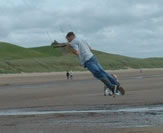 |
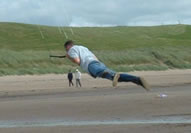 |
NB. The flight and landing is as the Sweep. The magnitude of the jump is controlled by how far down the window you reverse the kite, the further down the wind window equals bigger air.
The purpose of the pit is to provide something for your feet to brace against when you sweep the kite, so can build up tremendous tension in the lines. When you finally decide to jump you are fired into the air like a cannonball.
Building A Pit
Pit location is critical. Choose a location – landing area downwind must be in soft sand. (If you are lucky the wind will be blowing down the length of the beach so you will have a very long strip of soft sand to land in, however if the wind is directly onshore will only have a narrow strip, which you must land in).
Dig the pit as big as you want. The important part is where you brace your feet. It needs to be vertical and about 1.5 feet deep. NB: If you’re using the sweep technique to jump then you need to continue the face round to the side so you can brace against the kite when it is on the edge of the window so it does not pull you out of the pit. Excavating the middle of the pit will enable you to lie back in it for maximum effect. Excavated sand can be piled out of the front. The jumping faces will need to be kept vertical, as they tend to be destroyed by jumpers. The advantage of a circular pit is that if the wind changes direction you just align yourself differently in it, i.e. no need to dig new faces.
Notes – Safety Tips
Don’t go jumping alone (Take someone with you that preferably can drive or can contact someone in the event of an accident).
Ensure your equipment is in good working order – fault free.
Choose a suitable location (large open space with very soft surface for landing)
Only jump when the wind is constant.
Wear as much protective padding as possible (helmet, ankle supports etc.)
It is advisable to warm up before attempting very large jumps i.e. start small.
Never let go of the kite lines when you are in the air.
It might be worthwhile investing in a First Aid Box!
Many people have been injured whilst kite jumping!
Thanks to http://www.kitezone.co.uk/